Brihadeeswarar Temple
| Brihadeeswara Temple Peruvudaiyaar Kovil UNESCO World Heritage Site | |
|---|---|
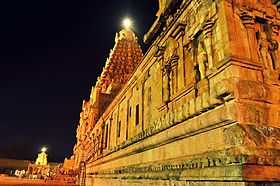 | |
| Coordinates: | 10°46′58″N 79°07′54″E / 10.78278°N 79.13167°ECoordinates: 10°46′58″N 79°07′54″E / 10.78278°N 79.13167°E |
| Name | |
| Other names: |
Brihadeeswara Temple Big Temple |
| Proper name: | Peruvudaiyaar Temple |
| Location | |
| Country: | India |
| State: | Tamil Nadu |
| District: | Thanjavur |
| Location: | Thanjavur |
| Architecture and culture | |
| Primary deity: | Lord Shiva |
| Important festivals: | Maha Shivaratri |
| Architectural styles: | Dravidian Architecture |
| History | |
| Date built: (Current structure) | 11th century AD |
| Creator: | Raja Raja Chola I |
The Peruvudaiyar Kovil, also known as Brihadeeswara Temple, RajaRajeswara Temple and Rajarajeswaram,[1] at Thanjavur in the Indian state of Tamil Nadu, is a Hindu temple dedicated to Shiva and an art of the work achieved by Cholas in Tamil architecture. The temple is part of UNESCO World Heritage Site and "Great Living Chola Temples".[2]
This is one of the largest temple in India[3] and one of India's most prized architectural sites. The temple stands amidst fortified walls that were probably added in the 16th century. The vimana (or temple tower) is 216 ft (66 m) high[4] and is among the tallest of its kind in the world. The Kumbam (Kalasha or Chikharam) (apex or the bulbous structure on the top) of the temple is carved out of a single stone and it weighs around 80 tons.[5]
There is a big statue of Nandi (sacred bull), carved out of a single rock, at the entrance measuring about 16 feet long and 13 feet high.[6] The entire temple structure is made out of granite, the nearest sources of which are close to Tiruchirappalli, about 60 km to the west of Thanjavur. Built in 1010 AD[7] by Raja Raja Chola I in Thanjavur, Peruvudaiyaar Temple, also popularly known as the ‘Big Temple', turned 1000 years old in 2010.
History

The temple had its foundations laid out by the Tamil emperor Arulmozhivarman, popularly called Rajaraja Chola I, (Tamil: இராசராச சோழன், Rājarāja Choļan ?) in 1002 CE, as the first of the great Tamil Chola building projects.[8]
The Brihadeeswarar Temple was built to grace the throne of the Chola empire in compliance to a command given to him in his dream.[6] The scale and grandeur is in the Chola tradition. An axial and symmetrical geometry rules the temple layout.[9] Temples from this period and the following two centuries are an expression of the Tamils (Chola) wealth, power and artistic expertise. The emergence of such features as the multifaceted columns with projecting square capitals signal the arrival of the new Chola style.[10]
The Brihadeeswarar Temple was built to be the royal temple to display the emperor's vision of his power and his relationship to the universal order. The temple was the site of the major royal ceremonies such as anointing the emperor and linking him with its deity, Shiva, and the daily rituals of the deities were mirrored by those of the king. It is an architectural exemplar showcasing the pure form of the Dravida type of temple architecture and representative of the Chola Empire ideology and the Tamil civilisation in Southern India. The temple "testify to the brilliant achievements of the Chola in architecture, sculpture, painting and bronze casting."[11]
Construction

The wish to build a mammoth temple like this is said to have occurred to Raja Raja while he stayed at Sri Lanka as an emperor.
The esteemed architect and engineer of the temple was Kunjara Mallan Raja Raja Perunthachan as stated in inscriptions found at the temple. The temple was built per ancient texts called Vaastu Shastras and Agamas. He is the ancient ancestor of the doyan of Vaastu Vedic architecture, the late Dr. V. Ganapti Sthapati of Chennai and Mahabalipurim (architect of the 133' granite Thiruvalluvar statue at the tip of south India). Members of his family still live and practice the ancient art and science. The American University of Mayonic Science and Technology was initiated by Dr. V. Ganapati Sthapati to perpetuate the same form of architectural principles used by Kunjara Mallan Raja Raja Perunthachan to build the Brihadeeswarar temple. The temple was built using a measure of 1 3/8 inch called an angula (24 units equaling 33 inches called a hasta, muzam, or kishku).
This temple is the first building fully built by granite and finished within 5yrs[1004AD – 1009AD]. The solid base of the temple raises about 5 metres (16 feet), above which stone deities and representatives of Shiva dance.[12] The huge kalasam or Vimanam (top portion of the shrine) is believed to weigh 81.28 tonnes was of 8 blocks and was raised to its present height by dragging on an inclined plane of 6.44 km.[13] The big Nandi (bull), weighing about 20 tonnes is made of a single stone and is about 2 m in height, 6 m in length and 2.5 m in width.[13] The presiding deity of lingam is 3.7m tall. The prakaram (outer precincts of the temple) measures 240m by 125m.[13] The outer wall of the upper storey is carved with 81 dance karanas – postures of Bharathanatyam, the classical dance of Tamil Nadu.[13] The shrine of Goddess was added by Pandyas during the 13th century, Subramanya Shrine by Vijayanagara rulers and the Vinayaka shrine was renovated by Maratha rulers.[13]
Temple complex
The temple complex sits on the banks of a river that was channelled to make a moat around the complex's outer walls, the walls being built like a fortress. The complex is made up of many structures that are aligned axially. The complex can be entered either on one axis through a five-story gopuram or with a second access directly to the huge main quadrangle through a smaller free-standing gopuram. The massive size of the main Vimanam (Shikhara) is ca. 60 meters high, with 16 elaborately articulated stories, and dominates the main quadrangle. Pilaster, piers, and attached columns are placed rhythmically covering every surface of the Vimanam.[14]
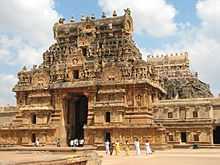
The gopuram of the main entrance is 30 m high, smaller than the vimana. It is unusual in the dravidian architecture where the gopurams are generally the main towers and taller than the vimana.[15]
Main temple

A first rectangular surrounding wall, 270 m by 140 m, marks the outer boundary.[15] The main temple is in the center of the spacious quadrangle composed of a sanctuary, a Nandi, a pillared hall and an assembly hall (mandapas), and many sub-shrines. The most important part of the temple is the inner mandapa which is surrounded by massive walls that are divided into levels by sharply cut sculptures and pilasters providing deep bays and recesses. Each side of the sanctuary has a bay emphasising the principle cult icons.[9] The karuvarai, a Tamil word meaning the interior of the sanctum sanctorum, is the inner most sanctum and focus of the temple where an image of the primary deity, Shiva, resides. Inside is a huge stone linga. The word Karuvarai means "womb chamber" from Tamil word karu for foetus. Only priests are allowed to enter this inner-most chamber.[16]
In the Dravida style, the Karuvarai takes the form of a miniature vimana with other features exclusive to southern Indian temple architecture such as the inner wall together with the outer wall creating a pradakshina around the garbhagriha for circumambulation (pradakshina). The entrance is highly decorated. The inside chamber housing the image of the god is the sanctum sanctorum, the garbhagriha.[10] The garbhagriha is square and sits on a plinth, its location calculated to be a point of total equilibrium and harmony as it is representative of a microcosm of the universe. In the center is placed the image of the deity.[9] The royal bathing-hall where Rajaraja the great gave gifts is to the east of the hall of Irumudi-Soran.
The circumambulation winds around the massive lingam in the garbhagriha and is repeated in an upper story, presenting the idea that Chola Empire freely offered access to the gods.[14]
The inner mandapa leads out to a rectangular mandapa and then to a twenty-columned porch with three staircases leading down. Sharing the same stone plinth is a small open mandapa dedicated to Nandi, Shiva's sacred bull mount.[9]

Temple Deities
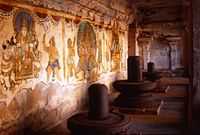
The "moolavar" or prime deity of the Brihadeeswarar Temple is Shiva. All deities, particularly those placed in the niches of the outer wall (Koshta Moorthigal) like Dakshinamurthy, Surya, Chandra are of huge size. The Brihadiswarar temple is one of the rare temples which has idols for "Ashta-dikpaalakas" (Guardians of the directions) — Indra, Agni, Yama, Nirṛti, Varuṇa, Vāyu, Kubera, Īśāna – each of whom was originally represented by a life-sized statue, approximately 6 feet tall, enshrined in a separate temple located in the respective direction. (Only Agni, Varuṇa, Vāyu and Īśāna are preserved in situ.)
Adjoining structures
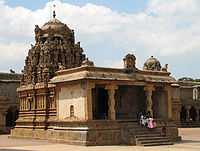
Surrounding the main temple are two walled enclosures. The outer wall is high, defining the temple complex area. Here is the massive gopuram or gateway mentioned above. Within this a portico, a barrel vaulted gorpuram with over 400 pillars, is enclosed by a high wall interspersed with huge gopurams axially lined up to the main temple.
Myths
The 60-metre tall Vimana is the tallest in South India. A European-like figure which is carved on the Vimana is believed to be an ancient warning of the arrival of the Europeans. Later investigations by archaeologists proposed that this claim may be a hoax.
Features
Another widely held belief is that the shadow of the gopuram (pyramidal tower usually over the gateway of a temple) never falls on the ground. .[17] The temple is said to be made up of about 130,000 tons of granite. The Kumbam itself, a 60 ton granite stone carved in one piece, on top of the main gopuram is believed to have been taken to the top by creating an inclined slope to the height of 66m to the top of the gopuram. The prevailing belief is that a mud-slope, which starts at about three miles from the temple site, from Thirukoilore (birthplace of Raja raja's mother) near Sri Virateshvara swamy temple. Elephants might have been used to drag the stone up the slope. This was claimed to be the only part of the gopuram, which does not cast a shadow that fall on the ground, at least not within the temple premises.
Murals

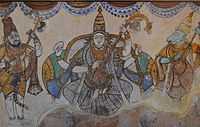

The temple has Chola frescoes on the walls around the sanctum sanctorum potryaing Shiva in action, destroying demonic forts, dancing and sending a white elephant to transport a devotee to heaven.[12] These frescoes were discovered in the 1940s and portray the mythological episodes of the journey of Saint Sundarar and the Chera King to heaven, the battle scene of Tripurantaka (Lord Siva) with Asuras (demons).[18] The Chola artists have proved their mettle by portraying even the Asura women with a sense of beauty.[18] Some of the paintings in the sanctum sanctorum and the walls in the passage had been damaged because of the soot that had deposited on them. Owing to the continuous exposure to smoke and soot from the lamps and burning of camphor in the sanctum sanctorum over a period of centuries certain parts of the Chola paintings on the circumambulatory passage walls had been badly damaged.[18] The Tanjore Nayak kings replaced them with a few paintings of their own, about 400 years ago.[18] The Archaeological Survey of India, for the first time in the world, used its unique de-stucco process to restore 16 Nayak paintings, which were superimposed on 1000-year-old Chola frescoes.[18] These 400-year-old paintings have been mounted on fibre glass boards, displayed at a separate pavilion.[18]
Temple personnel
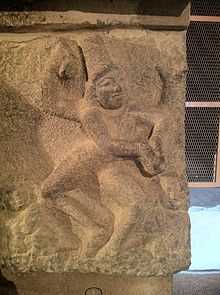
The temple was consecrated in 1010 CE by Raja Raja Chola I & in 2010 a celebration commemorated the temple's thousandth anniversary. The temple maintained a staff of 1000 people in various capacities with 400 being temple dancers[13] Besides the Brahmin priests, these included record-keepers, musicians, scholars, and craftsman of every type as well as housekeeping staff. In those days the temple was a hub of business activities for the flower, milk, oil, and ghee merchants, all of whom made a regular supply of their respective goods for the temple for its poojas and during festival seasons. Moreover as evidenced by the inscriptions that found in the compound wall of this temple, the temple had always been serving as a platform for the dancers who excelled in the traditional dance form of Bharatnatyam.[19] vallamuthu minnadi generation worshipped this temple.
Millennium celebrations


Built in the year 1010ce by Raja Raja Chola in Thanjavur, Brihadeeswarar Temple popularly known as the ‘Big Temple’ turned 1000 years old in September 2010. To celebrate the 1000th year of the grand structure, the state government and the town held many cultural events. It was to recall the 275th day of his 25th regal year (1010 CE) when Raja Raja Chola (985–1014 CE) handed over a gold-plated kalasam (copper pot or finial) for the final consecration to crown the vimana, the 59.82-metre tall tower above the sanctum.[20][21][22]
Bharathanatyam Yajna
To mark the occasion, the state government organised a Bharathanatyam Yajna, classical dance show under noted dancer Padma Subramaniam. It was jointly organised by the Association of Bharatanatyam Artistes of India (ABHAI) and the Brhan Natyanjali Trust, Thanjavur. To mark the 1000th year anniversary of the building, 1000 dancers from New Delhi, Mumbai, Pune, Tamilnadu, Andhra Pradesh, Karnataka, Kerala, Singapore, Malaysia and the U.S. danced in concert to the recorded 11 verses of divine music Thiruvichaippa (ninth of Thirumurai) composed by Karuvur Thevar (the guru of Raja Raja Chola) named Tiruvisaippa. The small town turned into a cultural hub for two days beginning 26 September 2010 as street performers and dancers performed throughout the town.[23][24]
Commemorative stamps and coins
On 26 September 2010 (Big Temple’s fifth day of millennium celebrations), as a recognition of Big Temple’s contribution to the country’s cultural, architectural, epigraphical history, a special ![]() 5 postage stamp featuring the 216-feet tall giant Raja Gopuram was released by India Post.
5 postage stamp featuring the 216-feet tall giant Raja Gopuram was released by India Post.
The Reserve Bank of India commemorated the event by releasing a ![]() 5 coin with the model of temple embossed on it.[25][26] A Raja, Cabinet Minister of Communications and Information Technology released the esteemed Brihadeeswarar Temple special stamp, the first of which was received by G K Vasan, Cabinet Minister of Shipping.
5 coin with the model of temple embossed on it.[25][26] A Raja, Cabinet Minister of Communications and Information Technology released the esteemed Brihadeeswarar Temple special stamp, the first of which was received by G K Vasan, Cabinet Minister of Shipping.
A 1000 Rupees Commemorative Coin is also being released with the same picture as on the Rs 5 coin. This will be the first 1000 Rupees coin to be released in the Republic of India coinage. This coin will be a will be a Non Circulative Legal Tender (NCLT).
On 1 April 1954, the Reserve Bank of India released a ![]() 1000 currency note featuring a panoramic view of the Brihadeeswarar Temple marking its cultural heritage and significance. In 1975, the then government led by Prime Minister Indira Gandhi demonetised all
1000 currency note featuring a panoramic view of the Brihadeeswarar Temple marking its cultural heritage and significance. In 1975, the then government led by Prime Minister Indira Gandhi demonetised all ![]() 1,000 currency notes in an effort to curtail black money. These notes are now popular among collectors.[27]
1,000 currency notes in an effort to curtail black money. These notes are now popular among collectors.[27]
Tamil Nadu chief minister, M Karunanidhi renamed Semmai Paddy, a special type of high productivity paddy variant, as Raja Rajan-1000 to mark the millennial year celebration of the Big Temple’s builder, Raja Raja Cholan.[28]
Brihadeeswarar Temple in historic novels
Balakumaran has written a novel Udaiyar (Printed and Published through VISA publications in Tamil nadu) themed on the life of Raja Raja Chola I and the construction of the Brihadeeswarar temple. Kalki has also written a novel "Ponniyin Selvan" based on the life of Raja Raja Chola I.
In News
During the consecration (Kumbhabhishekham) of 1997, 48 people were killed in a fire accident and 86 others injured.[29] The incident occurred hours before the Mahakumbabishekam ceremony.[30] It is believed a fire cracker lit near the temple fell on the yagasala, a temporary structure built to accommodate the ritual ceremonies, and sparked the fire that spread to the thatched roofs.[30] A stampede resulted when the panic-stricken devotees rushed the only entrance to the temple on the eastern side.[30] However, another version claimed the fire was caused by a spark from the electric generator.[30] Most of the deaths were reported be caused by the inhalation of carbon monoxide and a few due to burn injuries. The Tamil Nadu Government announced a compensation of Rs 100,000 to the families of the deceased and the injured were paid from Rs 10,000 to Rs 50,000 each.[30]
There is widespread belief that a visit to the temple has politically disastrous implications – the claim is supported by a few events.[29] A visit to the temple for an event related to King Rajaraja by former Prime Minister Indira Gandhi along with the then Chief Minister of Tamil Nadu M G Ramachandran in 1984 was followed by bad course of events later for both the leaders – Mrs Gandhi was assassinated by her own bodyguards in October that year, and MGR fell seriously ill with a stroke.[29] Following the taboo, Karunanidhi, visited the site of the fire accident via the side entrance.[31] He denied the report stating he does not subscribe to the belief.[31] He also added that he had used a side entrance to the temple instead of the main one while visiting the accident spot, the way by which he was escorted by police officials.[31] Contrary to belief he believed he had scored resounding political victories after his earlier visits to the temple.[31]
Govt of India, Mumbai Mint issued Rs. 1000/- coin [32] to commemorate the 1000th year of the temple.
Travel information
Thanjavur can be reached easily by road, rail and air. Tamil Nadu state government runs frequent public buses from nearby Trichy, Chennai, Kumbakonam, Pudukkottai, Pattukkottai, Tirunelveli, Karur, Nagapattinam, Coimbatore,Erode and many other cities in the states. From the state capital Chennai, a National Highway (NH 45-A) linking Chennai with Chidambaram, Mayavaram, Kumbakonam, Thanjavur,Thiruvarur and Nagappatinam provides convenient access to tourists who come to visit Thanjavur and the adjoining towns. There are also several buses operated by private bus operators.
Rail services are run by Indian Railways from many cities across India including Chennai, Trichy, Coimbatore, Erode, Tirunelveli, Madurai and Nagore. The train station is Thanjavur Junction.
Tiruchirapalli Airport is the nearest airport, located 65 km away.
See also
- Raja Raja Chola I
- Chola Dynasty
Notes
- ↑ South Indian Inscriptions – Vol II, Part I & II
- ↑ "Tanjavur Periya Kovil Tamilnadu". Tamilnadu.com. 5 December 2012.
- ↑ Keay, John (2000). India, a History. New York, United States: Harper Collins Publishers. pp. xix. ISBN 0-00-638784-5.
- ↑ Middle Chola Temples, S.R.Balasubrahmanyam
- ↑ "The Archaeological Survey of India (ASI)".
- ↑ 6.0 6.1 Encyclopaedia of Political Parties By Ralhan, O. P.
- ↑ "Endowments to the Temple". Archaeological Survey of India.
- ↑ "The Chola Dynasty 300 B.C. to 1250 A.D.". kamat.com. Retrieved 2008-01-22.
- ↑ 9.0 9.1 9.2 9.3 Thapar 2004, pp.43, 52–53
- ↑ 10.0 10.1 Mitchell 1988, pp. 145–148
- ↑ "Great Living Chola Temples". UNESCO. Retrieved 2008-01-21.
- ↑ 12.0 12.1 Man 1999, p. 104
- ↑ 13.0 13.1 13.2 13.3 13.4 13.5 Various 2007, pp. 65–66
- ↑ 14.0 14.1 Ching 2007, pp. 338–339
- ↑ 15.0 15.1 http://whc.unesco.org/en/list/250
- ↑ "Architecture of the Indian Subcontinent – Glossary". Retrieved 2007-01-24.
- ↑ "Strong ground to dismiss popular belief". The Hindu (Chennai, India). 30 March 2004.
- ↑ 18.0 18.1 18.2 18.3 18.4 18.5 "ASI restores 400-year old paintings". The Hindu (Chennai, India). 28 February 2010. Retrieved 22 June 2010.
- ↑ Written in stone – Big Temple's inscriptions reveal a King's passion, T.S. Subramanian, CHENNAI, 24 September 2010, The Hindu
- ↑ BBC News augue (25 September 2010). "India's Big Temple marks 1,000th birthday". Retrieved 25 September 2010.
- ↑ PS. R. Balasubrahmanyam (1971), Orient Longman Publications. "Early Chola temples:Parantaka I to Rajaraja I, 907–985 A.D".
- ↑ Ananthacharya Indological Research Institute (1984). "Rāja Rāja, the great:seminar proceedings".
- ↑ Rediff News. "India's Biggest Temple turns 1000-years". Retrieved 20 August 2010.
- ↑ "A grand dance spectacle at the Thanjavur Big Temple". The Hindu (Chennai, India). 1 August 2010. Retrieved 20 August 2010.
- ↑ Deccan Herald (26 September 2010). "Stamp, coin release mark 1,000 years of Big Temple". Retrieved 26 September 2010.
- ↑ "Release of a special postal stamp and a five- rupee coin". The Hindu (Chennai, India). 27 September 2010. Retrieved 27 September 2010.
- ↑ Express Buzz, The Indian Express (26 September 2010). "INR 1000 note of 1954 popular in Tanjavur". Retrieved 27 September 2010.
- ↑ MSN News (26 September 2010). "Semmai Paddy as "Raja Rajan-1000"". Retrieved 27 September 2010.
- ↑ 29.0 29.1 29.2 "Hex fears doom temple gala". Deccan Herald (Chennai). June 2010. Retrieved 22 June 2012.
- ↑ 30.0 30.1 30.2 30.3 30.4 "40 killed in Thanjavur temple fire". Thanjavur: Rediff.com. June 1997. Retrieved 22 June 2012.
- ↑ 31.0 31.1 31.2 31.3 "No jinx associated with Big Temple: TN CM". The Indian Express (Chennai, India). 9 June 1996. Retrieved 22 June 2012.
- ↑ "Release of Commemorative Coin". 3 July 2012.
References
- Ching, Francis D.K. (2007). A Global History of Architecture. New York: John Wiley and Sons. pp. 338–339. ISBN 0-471-26892-5.
- Mitchell, George (1988). The Hindu Temple. Chicago: University of Chicago Press. pp. 145–148. ISBN 0-226-53230-5.
- Man, John (1999). Atlas of the Year 1000. United Kingdom: Penguin Books. ISBN 0-7946-0011-5.
- Thapar, Binda (2004). Introduction to Indian Architecture. Singapore: Periplus Editions. pp. 43, 52–53. ISBN 0-7946-0011-5.
- Various (2007). Tourist Guide to Tamil Nadu. Chennai: Tourist Guide to Tamil Nadu. ISBN 978-81-7478-177-2.
External links
| Wikimedia Commons has media related to Brihadisvara Temple. |
- Photos on art-and-archaeology web site
- Brihadeshvara Temple in Tamilnadu
- Unesco Great Living Chola Temples
- pdf file about the temple and the Kandariya Mahadeva temple in Khajuraho
| ||||||||||||||||||||||||||
| ||||||||||||||||||||||||||||||||

